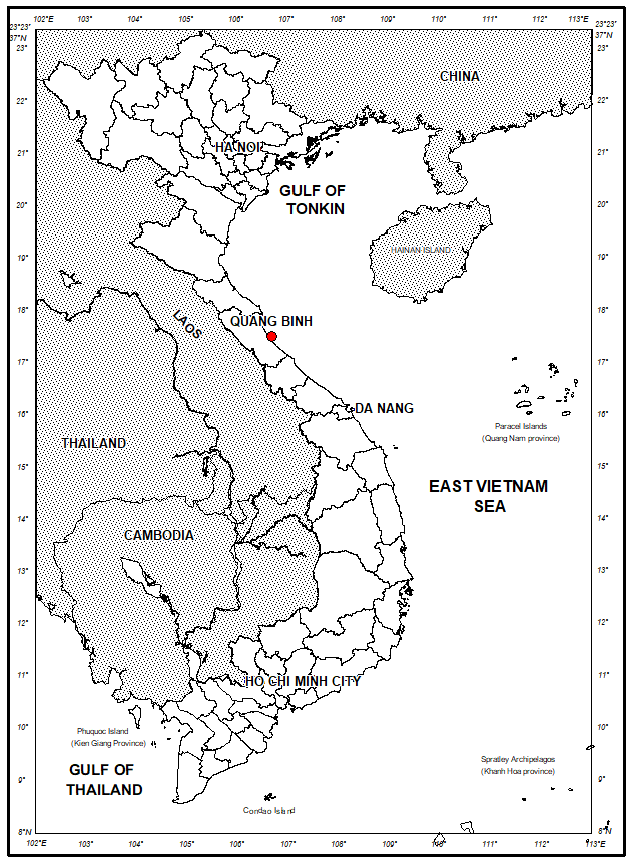Application of ANN for coastal water quality prediction: Quang Binh case study
Author affiliations
DOI:
https://doi.org/10.15625/0866-7136/20350Keywords:
prediction, pollution, total coliform, Quang Binh provinceAbstract
The coastal areas of Quang Binh province play a crucial role not only in the economic and tourism development of the coastal province but also in the overall development of the Northern Central region. Therefore, monitoring and forecasting seawater quality in this region is vital. However, the water quality condition assessment faces many limitations due to the lack of measured data and the complication of numerical models. Meanwhile, the artificial intelligence model for simulating and predicting water quality has been widely applied due to its timely and reliable calculating abilities. This research has piloted the prediction of some water pollution parameters on the coast of Quang Binh province using an artificial neural network (ANN) model. This presents a novel approach to identifying implicit relationships between variables based on data analysis techniques via ANN. An ANN model was built to analyze the measured environmental time series data at Dong Hoi station, Quang Binh province, from 2002 to 2022. The calculation results of the training (70% of the data set, NSE: 0.81) and testing (the rest 30% of the data set, NSE: 0.5) of the model have satisfied the total coliform parameter, indicating the promise of applying the ANN model for water quality prediction.
Downloads
References
E. Dogan, B. Sengorur, and R. Koklu. Modeling biological oxygen demand of the Melen River in Turkey using an artificial neural network technique. Journal of Environmental Management, 90, (2009),
M. Heydari, E. Olyaie, H. Mohebzadeh, and Ö. Kisi. Development of a neural network technique for prediction of water quality parameters in the Delaware River, Pennsylvania. Middle-East Journal of Scientific Research, 13, (2013), pp. 1367–1376.
S. H. Musavi-Jah and M. Golabi. Application of artificial neural networks in the river water quality modeling: Karoon River, Iran. Journal of Applied Sciences, 8, (2008), pp. 2324–2328.
K. P. Singh, A. Basant, A. Malik, and G. Jain. Artificial neural network modeling of the river water quality—A case study. Ecological Modelling, 220, (2009), pp. 888–895.
D. Ömer Faruk. A hybrid neural network and ARIMA model for water quality time series prediction. Engineering Applications of Artificial Intelligence, 23, (2010), pp. 586–594.
R. Gupta, A. N. Singh, and A. Singhal. Application of ANN for water quality index. International Journal of Machine Learning and Computing, 9, (2019), pp. 688–693.
P. Sundarambal, S. Y. Liong, P. Tkalich, and P. Jegathambal. Development of a neural network model for dissolved oxygen in seawater. Indian Journal of Marine Sciences, 38, (2), (2009), pp. 151–159.
S. Palani, S.-Y. Liong, and P. Tkalich. An ANN application for water quality forecasting. Marine Pollution Bulletin, 56, (2008), pp. 1586–1597.
H. T. An. Research combines hydraulic and artificial intelligence models to simulate the water quality of the Nhu Shi-Dai River. Journal of Hydrological Meteorology, 739, (2022), pp. 67–80.
P. N. Hoai, P. B. Quoc, and T. Thanh Thai. Apply machine learning to predict saltwater intrusion in the Ham Luong river, Ben Tre province. VNU Journal of Science: Earth and Environmental Sciences, 38, (2022).
T. H. Tran. Application of MIKE 21 FM modelling to simulate the water quality at the coastal area Ðình Vũ. Science and Technology Development Journal - Natural Sciences, 1, (2017), pp. 282–292.
N. D. Phong and H. H. Duong. Applied studies of machine learning models to predict surface water quality indicators in the Ca Mau Peninsula. Journal of Hydraulic Science and Technology, 76, (2023), pp. 1–12.
C. K. Nguyen, T. H. D. Thi, H. N. Thi, T. H. Do, and T. D. Nguyen. Applying gridded rainfall data to calculate inflow discharge into Ban Chat hydropower reservoir basin. In Proceedings of the 7th International Conference on Engineering Mechanics and Automation, Publishing House for Science and Technology, ICEMA 2023, (2023), pp. 147–152.
Institute of Mechanics. Annual Summary Report "Marine environment monitoring in the Central part of Vietnam" from 2002 to 2022.
D. N. Moriasi, J. G. Arnold, M.W. V. Liew, R. L. Bingner, R. D. Harmel, and T. L. Veith. Model evaluation guidelines for systematic quantification of accuracy in watershed simulations. Transactions of the ASABE, 50, (3), (2007), pp. 885–900.

Downloads
Published
How to Cite
Issue
Section
Categories
License

This work is licensed under a Creative Commons Attribution-ShareAlike 4.0 International License.
Funding data
-
Vietnam Academy of Science and Technology
Grant numbers CT0000.04/21-22









